Companion Plants
last update Jun
2020
A few tuberous/bulbous plants which have increased here
nicely over the years and which I'm now prepared to dig and send out in fall when
the peonies are dug. The Arisaemas, related to the native Jack-in-the-Pulpit,
are not exactly good companions in a peony bed as they may get shaded out by the
peony leaves but they're companionable in terms of shipping. The Corydalis
solida, on the other hand, is great amongst peonies because it blooms before
the peonies break dormancy and the foliage dies off in June before the peonies
reach full size, so light competition isn't a problem for them.
Arisaema
ciliatum var. liubaense 2057 $20.00
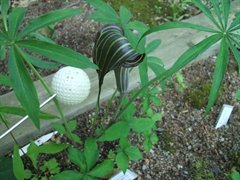 | 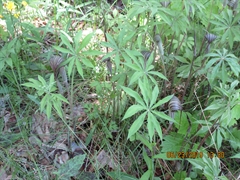 |
| flower | group
of plants (excuse the "weeds") |
Common
name(s): Asian Cobra Lily (one of several called so). From seed started in about
2005.This has been a most obliging species of Arisaema for me, increasing nicely
over time to a fine clump, whether stonloniferously or by self-seeding I can't
tell, probably both? Mine have been happy in a thick layer of sand and compost
mix over former lawn (heavy clay) and a few feet from the basement wall (on the
outside, of course!). Morning sun, dappled mid-day shade, full shade in the evening.
They emerge very quickly in late June. The flower (spathe) has a long tail hanging
down off the front. Seeds are borne in a spike of berries which turn bright red
in fall; they can be heavy enough to flatten to the earth, so their show can be
enhanced with a bit of early staking.
Arisaema sikokianum 0491 $40.00
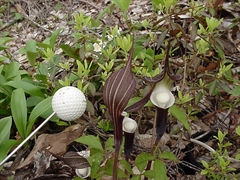 | 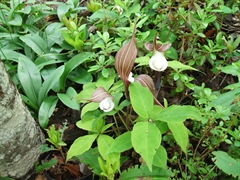 |
| flowers | plants |
Common
name(s): Japanese Cobra Lily. Quietly showy plants for a shady spot, but not too
shady. For good drainage in a compost-rich soil. Flowers and leaves appear rather
suddenly in late June. Seeds are (with luck, see next para) borne in a spike of
green berries which, if winter holds off long enough, ripen to red. The above
plants were started from seed obtained from a few sources about 20 years ago.
There
is a strain of A. sikikianum which has a fine light pattern on the leaves,
but these are unpatterned.
Arisaemas
are interesting plants in that: in most species their first few years of flowers
are female only, then they tend to try being male for a few years, and then produce
flowers of both sexes (all forms have the same aesthetic presentation for the
gardener; the actual flowers are tiny things on the interior 'mushroom'-capped
spike called a spadix). So it took quite awhile for one of my plants to produce
some berries and another while for me to manage to get them to ripen properly
(just once...). So I finally have a crop of youngsters on offer. They've been
in the ground for 4winters (maybe 5? it's a bit fuzzy in my mind) and although
I was hopeful to see a few flowers this spring, they haven't yet. So what I'm
selling right now are unflowered tubers. There's no reason to believe there are
any hybrids in the bunch, as the parent plant was quite a distance away from any
other Arisaemas.
Corydalis solida 1401 $6.00
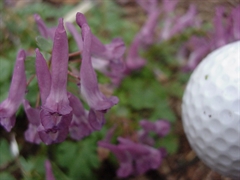 | 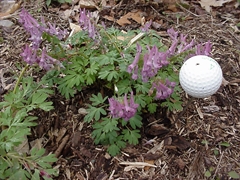 | 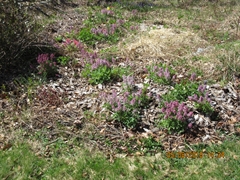 |
flowers | plant | a
group, showing some of the colour variation (but not the yellow or blue in the
far back!) |
A
low, early blooming ephemeral plant native to woods in Siberia, hardy at least
to Zone 5. If you've been frustrated (as I have) by the more difficult blue Corydalis,
don't give up on the genus until you've tried this species. Here it is fully hardy
and vigorous, increasing by offsets and self-seeding happily. Grows well in full
sun or part shade. It emerges early in spring, flowers for several weeks, and
goes dormant by late June. Although the individual flowers and plants are small,
their show is quite vibrant. Colour range of this lot is various mid shades of
lilac/mauve/lavender but the species can also range from white through pink to
red. The bulbs I'm selling will come out of one or more of the bunches in the
photo on the right. Or try some of the red ones below:
Corydalis solida red form 1401C $10.00
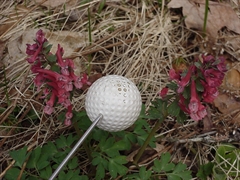 | 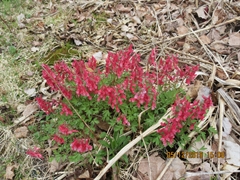 |
| flowers | plant
cluster (about 30cm across) |
A particularily vibrant
colour; the group on the right is easily visible from over 35m distance despite
the small size of the flowers. Bulbs being sold will come from that group, which
originated as a seedling from the cultivar "George Baker" in about 2004.
If
you start with 1 each of 1401 and 1401C and keep them apart for a few years, then
plant a few of the offsets of each together, nature's paintbrush will get started
on a mix of colours for you.
If you
have arrivedhere from a Search Engine like Google,
click
here to display the SITE INDEX.
Other Navigation Links at bottom of page.
Prices include all taxes and handling fees.
See Order Form for shipping costs. Canada only!
...
Index (frames) ... Index
(no frames) ...
... Home
...








